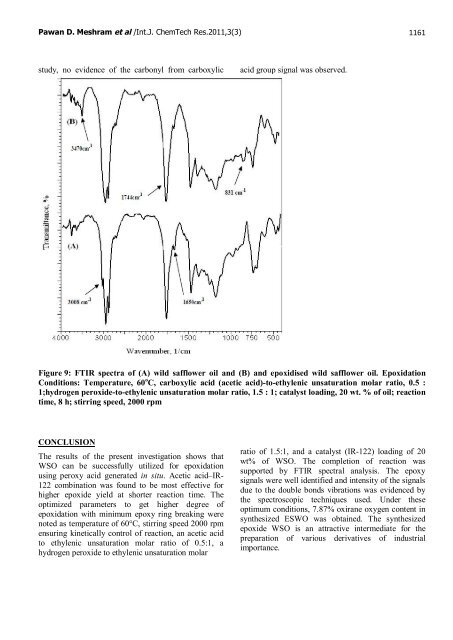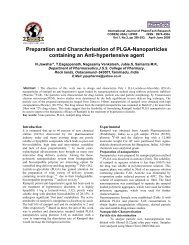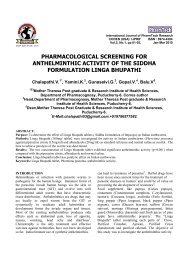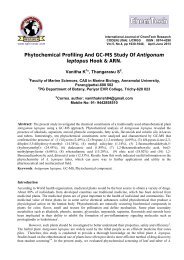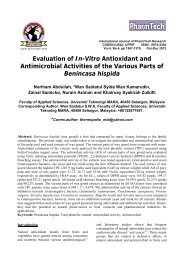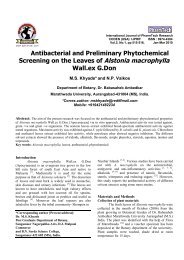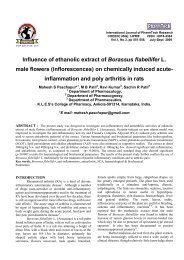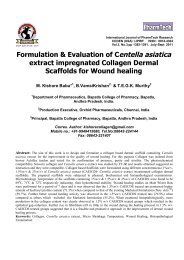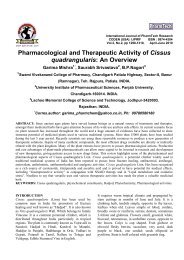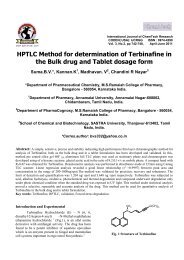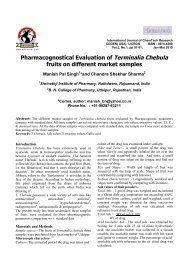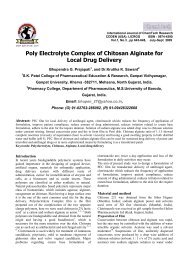Pawan D. Meshram et al /Int.J. ChemTech Res.2011,3(3) 1161 study, no evidence <strong>of</strong> the carbonyl from carboxylic acid group signal was observed. Figure 9: FTIR spectra <strong>of</strong> (A) <strong>wild</strong> <strong>safflower</strong> oil and (B) and epoxidised <strong>wild</strong> <strong>safflower</strong> oil. Epoxidation Conditions: Temperature, 60 o C, carboxylic acid (acetic acid)-to-ethylenic unsaturation molar ratio, 0.5 : 1;hydrogen peroxide-to-ethylenic unsaturation molar ratio, 1.5 : 1; catalyst loading, 20 wt. % <strong>of</strong> oil; reaction time, 8 h; stirring speed, 2000 rpm CONCLUSION The results <strong>of</strong> the present investigation shows that WSO can be successfully utilized for <strong>epoxidation</strong> using peroxy acid generated in situ. Acetic acid–IR- 122 combination was found to be most effective for higher epoxide yield at shorter reaction time. The optimized parameters to get higher degree <strong>of</strong> <strong>epoxidation</strong> with minimum epoxy ring breaking were noted as temperature <strong>of</strong> 60°C, stirring speed 2000 rpm ensuring kinetically control <strong>of</strong> reaction, an acetic acid to ethylenic unsaturation molar ratio <strong>of</strong> 0.5:1, a hydrogen peroxide to ethylenic unsaturation molar ratio <strong>of</strong> 1.5:1, and a catalyst (IR-122) loading <strong>of</strong> 20 wt% <strong>of</strong> WSO. The completion <strong>of</strong> reaction was supported by FTIR spectral analysis. The epoxy signals were well identified and intensity <strong>of</strong> the signals due to the double bonds vibrations was evidenced by the spectroscopic techniques used. Under these optimum conditions, 7.87% oxirane oxygen content in synthesized ESWO was obtained. The synthesized epoxide WSO is an attractive intermediate for the preparation <strong>of</strong> various derivatives <strong>of</strong> industrial importance.
Pawan D. Meshram et al /Int.J. ChemTech Res.2011,3(3) 1162 REFERENCES 1. Le P. L., Wan Yunus W.M.Z., Yeong S. K., Dezulkelfly K. A., Lim W. H., “Optimization <strong>of</strong> the <strong>epoxidation</strong> <strong>of</strong> methyl ester <strong>of</strong> palm fatty acid distillate” J. Oil Palm Res., 2009, 21, 675-682. 2. Holser R. A., “Transesterification <strong>of</strong> epoxidized soybean oil to prepare epoxy methyl esters”, Ind. Crops and Products, 2008, 27, 130-132. 3. Goud V.V., Mungroo R., Pradhan N.C., and Dalai A.K., “Modification <strong>of</strong> epoxidised canola oil”, Asia-Pacific J. Chem. Eng., 2011, 6, 14–22. 4. Dahlke B., Hellbardt S., Paetow M., Zech W.H., “Polyhydroxy fatty acids and their derivatives from plant oils”, J. Am. Oil Chem. Soc., 1995, 72, 349–353. 5. Okieimen F.E, Pavithran C., Bakare I.O., “Epoxidation and hydroxylation <strong>of</strong> rubber seed oil: one-pot multi step reactions”, Euro. J. Lipid Sci. & Tech., 2005, 107, 864-870. 6. Patwardhan A.V., Goud V.V., Pradhan N.C., “Epoxidation <strong>of</strong> Karanja (Pongamia glabra) Oil by H2O2”, J. Am. Oil Chem. Soc., 2006, 83, 247-252. 7. Carlson K.D., Kleiman R., Bagby M.O, “Epoxidation <strong>of</strong> lesquerella and limmanthes (meadowfoam ) oil” , J. Am. Oil Chem. Soc., 1994, 71, 175-182. 8. Marcel S.F., Lei K. J. and Mohammad K.P., “Epoxidation reactions <strong>of</strong> unsaturated fatty esters with peroxomonosulphate”, Lipids, 1998, 33, 633- 637. 9. Sonnet P. E. and Foglia T., “Epoxidation <strong>of</strong> natural triglycerides with ethyl methydioxyrane”, J. Am. Oil Chem. Soc., 83, 835-840. 10. Aerts A. J., Jacob P.A., “Epoxide yield determination <strong>of</strong> oils and fatty acid methyl esters using 1 H NMR”, J. Am. Oil Chem. Soc., 2004, 81, 841-846 11. Gurbanov M. S., and Mamedov B. A., “Epoxidation <strong>of</strong> Flax Oil with Hydrogen Peroxide in a Conjugate System in the presence <strong>of</strong> Acetic Acid and Chlorinated Cation Exchanger KU-2×8 as Catalyst”, Russian J. App. Chem., 2009, 82, 1483-1487. 12. Khot S. N., Lascala J. J., Can E., Moyre S. S., Williams, G. I., Palmese ,G. R., Kusefoglu, S. H. and Wool, R.P., “Development and Application <strong>of</strong> Triglyceride-Based Polymers and Composites”, J. Appl. Polym. Sci., 2001, 82, 703-723. 13. Biermann U., Friedt W., Lang S., Luhs W., Machmuller G., Metzger J. O., Klaas M. R., Schafer H.J. and Schneider M.P., “New Synthesis with Oils and Fats as Renewable Materials for the Chemical Industry”, Agew. Chem. Int. Ed., 2000, 39, 2206-2224. 14. Muturi P., Wang D., and Dirlikov S., “Epoxidized vegetable oils as reactive diluents. I. Comparison <strong>of</strong> vernonia, epoxidized soybean and epoxidized linseed oil”, Progress in Organic Coatings, 1994, 25, 85-94. 15. Adhvaryu A., Erhan S.Z., “Epoxidized soybean oil as a potential source <strong>of</strong> high-temperature lubricants”, Industrial Crops and Products, 2002, 15, 247-254. 16. Soucek M. D., Johnson A. H., Wegner J. M., “Ternary evaluation <strong>of</strong> UV-curable seed oil inorganic/organic hybrid coatings using experimental design” Progress in Organic Coatings, 2004, 51, 300-311. 17. Zhang L.P., “Safflower: a versatile plant”, IV International Safflower Conf., Bari, 2-7 June, 1997, 311-329. 18. Hilker D., Bothe J. P. and Warnecke H.J., “Chemo-Enzymatic Epoxidation <strong>of</strong> Unsaturated Plants Oils”, Chemical Engineering Science, 2001, 56, 427-432 19. Anjani K., Mukta N. and Lakshmamma P., “Crop improvement: In <strong>Research</strong> Achievements in Safflower”, Directorate <strong>of</strong> Oilseeds <strong>Research</strong>, Hyderabad, India, 11. 20. Ravikumar R.L., Soregaon C.D. and Satish D., “Molecular diversity analysis <strong>of</strong> five different species <strong>of</strong> genus Carthamus”, National Seminar on Changing Global Vegetable Oils Scenario: Issues and Challenges before India”, Directorate <strong>of</strong> Oilseeds <strong>Research</strong>, Hyderabad, India, 29-31 January, 2007, 2-4. 21. Ashri A., Zimmer D.E., Urie A.L., Cahaner A. and Marani A., “Evaluation <strong>of</strong> world collection <strong>of</strong> <strong>safflower</strong> Carthamus tinctorius L. yield and yield components and their relationships”, Crop Sci., 1974, 14, 799-802. 22. Banergy R., Pandey V. and Dixit B. S., “Wild Safflower: An alternative source <strong>of</strong> <strong>safflower</strong> oil”, J. Oil Tech. Assoc. Ind., 1999, 31, 59-60. 23. Dalai A.K., Mungroo R., Pradhan N.C., Goud V.V. ,“ Epoxidation <strong>of</strong> canola oil with hydrogen peroxide catalyzed by acidic ion exchange resin”, J. Am. Oil Chem. Soc.,2008, 85, 887-896. 24. Petrovic Z. S., Zlatanic A., Lava C.C., Sinadinovic-Fiser S., Epoxidation <strong>of</strong> soybean oil in toluene with peroxoacetic and perox<strong>of</strong>ormic acids. Kinetics and side reactions”, Eur. J. Lipid Sci. & Tech., 2002, 104, 293–299.


